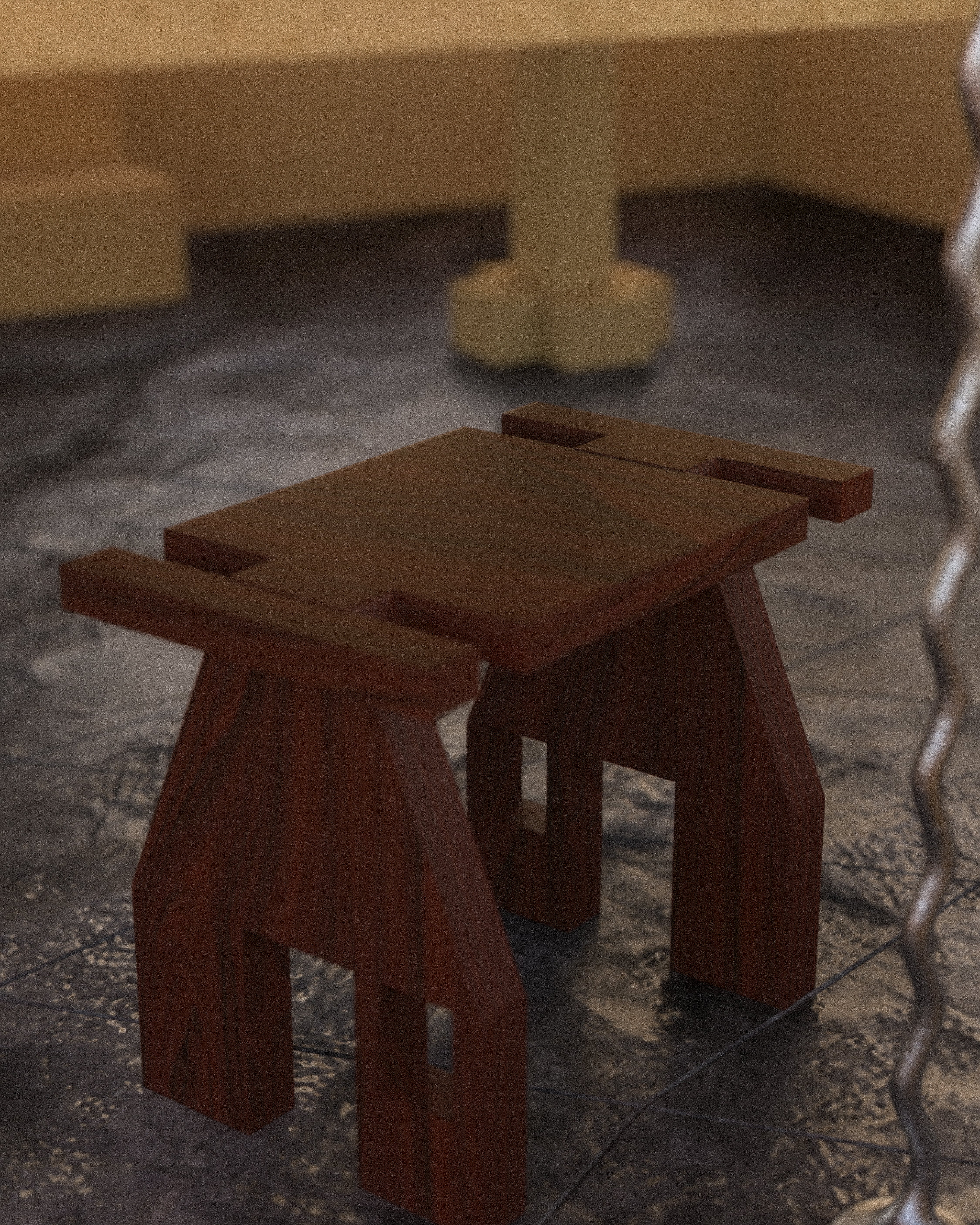
Le “Ti’ban”
Context : this little stool is a true testimony to the history of the Caribbean, it is a marker of local culture. This modest craft object was a multi-purpose piece of furniture found in the homes of slaves. Like a friend you never left behind, it was used as a seat, a piece of furniture for washing, fishing, washing clothes and so on.
It is handmade from a variety of northern (European) woods salvaged from crates imported to the island.
This nomadic object illustrates conviviality, mutual aid and sharing. It stands at the crossroads of worlds and eras.
Design : the two legs of the "ti'ban" (little stool) of the Guiablesse mimic the traditional facade of the Creole huts found in Martinique towns. The seat is designed for a skillful and efficient grip.
Context : this little stool is a true testimony to the history of the Caribbean, it is a marker of local culture. This modest craft object was a multi-purpose piece of furniture found in the homes of slaves. Like a friend you never left behind, it was used as a seat, a piece of furniture for washing, fishing, washing clothes and so on.
It is handmade from a variety of northern (European) woods salvaged from crates imported to the island.
This nomadic object illustrates conviviality, mutual aid and sharing. It stands at the crossroads of worlds and eras.
Design : the two legs of the "ti'ban" (little stool) of the Guiablesse mimic the traditional facade of the Creole huts found in Martinique towns. The seat is designed for a skillful and efficient grip.
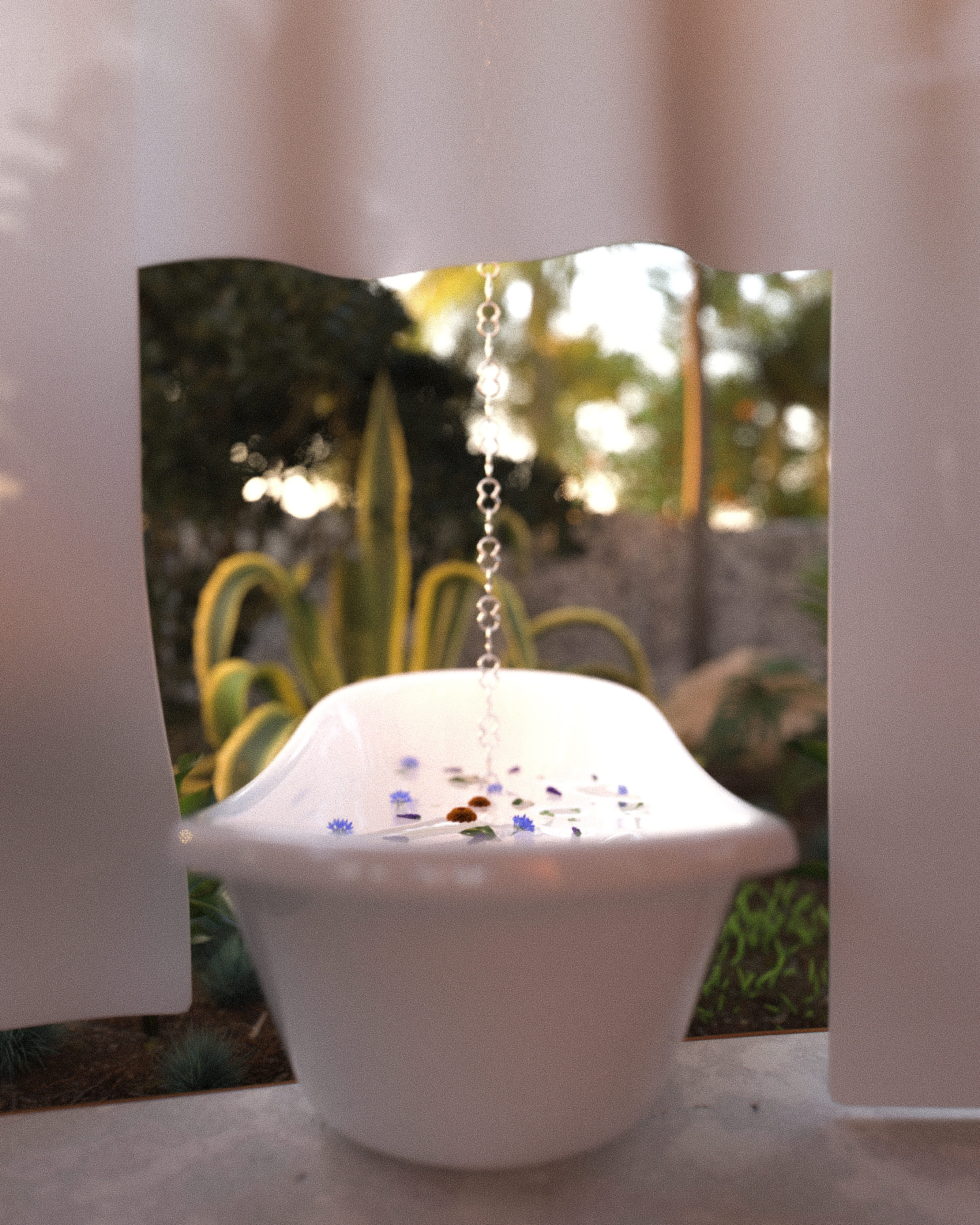
Le Bain “Démaré”
Halfway between inside and outside, this bath is filled using a rain chain connected to the four-sided roof of the hut. The rain chain is inspired by the coffee bean chain, a marker of many symbols, both painful in terms of oppression, but also human in terms of social relations and mutual aid.
The floor of the hut is slightly higher than the ground. As a result, two of the four feet of the bath have been removed. The bath is gently placed on the inner floor, while the two outer feet keep the bath horizontal.
The bath is not a simple bath, but a real purification ritual, known in the West Indies as the "démaré" bath. The aim is to rid ourselves of all negative influences and to manifest our deepest desires. Among other actions, this protocol includes filling the bath with a multitude of magic leaves and flowers.
The curtain that separates the inside from the outside is pierced by a hole that frames and directs the gaze. As if looking at a painting of a flamboyant landscape, La Guiablesse contemplates her Eden while revelling in her "démaré" bath.
Halfway between inside and outside, this bath is filled using a rain chain connected to the four-sided roof of the hut. The rain chain is inspired by the coffee bean chain, a marker of many symbols, both painful in terms of oppression, but also human in terms of social relations and mutual aid.
The floor of the hut is slightly higher than the ground. As a result, two of the four feet of the bath have been removed. The bath is gently placed on the inner floor, while the two outer feet keep the bath horizontal.
The bath is not a simple bath, but a real purification ritual, known in the West Indies as the "démaré" bath. The aim is to rid ourselves of all negative influences and to manifest our deepest desires. Among other actions, this protocol includes filling the bath with a multitude of magic leaves and flowers.
The curtain that separates the inside from the outside is pierced by a hole that frames and directs the gaze. As if looking at a painting of a flamboyant landscape, La Guiablesse contemplates her Eden while revelling in her "démaré" bath.

Le “Ti’feu”
The little fire allows La Guiablesse to heat its water, which is slightly cooled by the morning dew. Its terracotta container holds small logs. And the handles give this object a nomadic character. It is also used in the bedroom under the bed to keep mosquitoes away.
The little fire allows La Guiablesse to heat its water, which is slightly cooled by the morning dew. Its terracotta container holds small logs. And the handles give this object a nomadic character. It is also used in the bedroom under the bed to keep mosquitoes away.
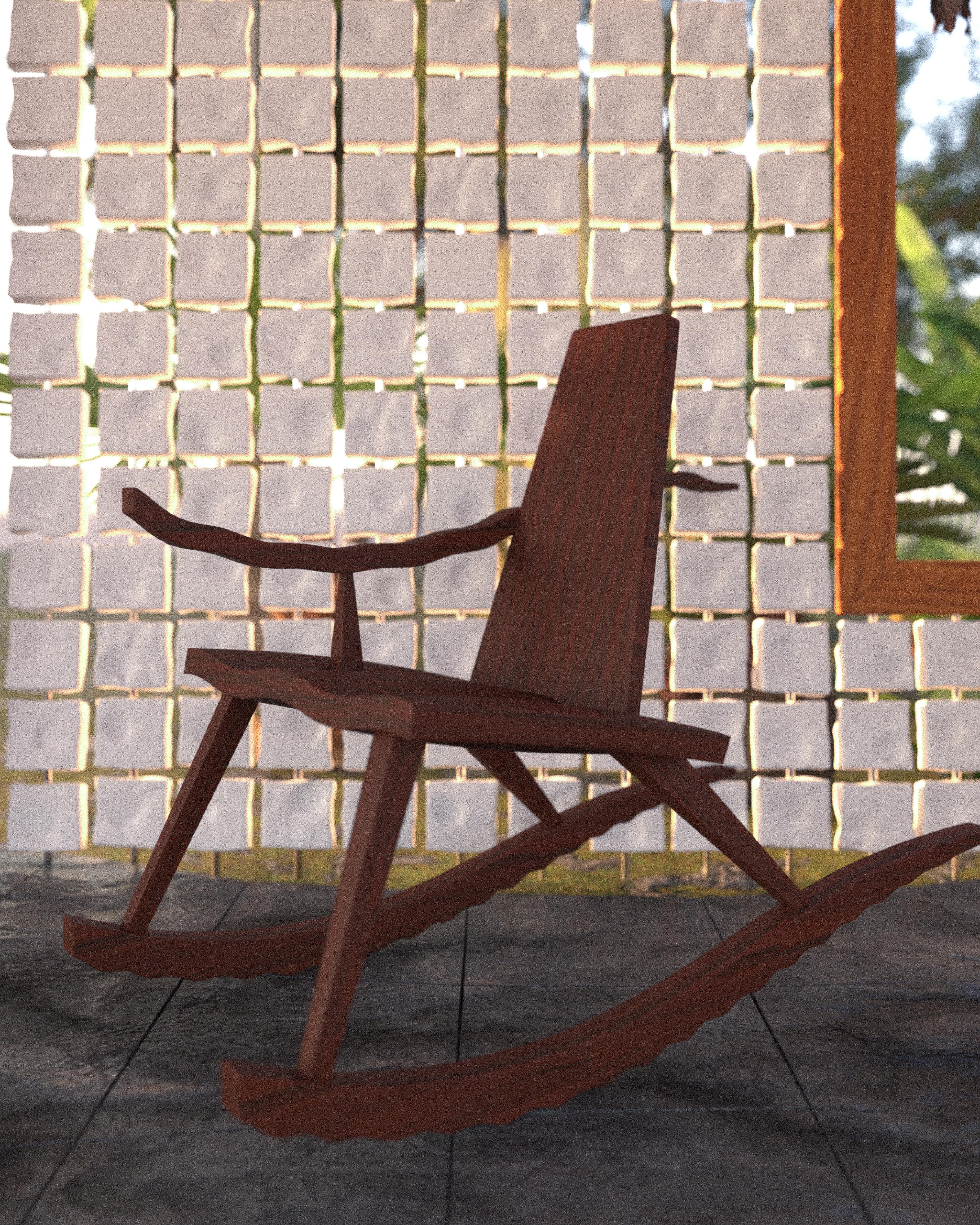
La “Dodine”
Context : or the Creole lullaby is one of the most representative object of the gentle way of life in the West Indies. Like most traditional furniture, the lullaby is made from mahogany wood.
Design : the wavy legs create a "turbulent" movement when you swing on it. Like the Guiablesse with its goat's foot, this cradle is intriguing with its single armrest.
Context : or the Creole lullaby is one of the most representative object of the gentle way of life in the West Indies. Like most traditional furniture, the lullaby is made from mahogany wood.
Design : the wavy legs create a "turbulent" movement when you swing on it. Like the Guiablesse with its goat's foot, this cradle is intriguing with its single armrest.

The Pipe Holder
Context : La Guiablesse is more than a character, she represents the inhabitants and habits of her island. Like M'man Tine in "Rue Case Nègre", the Guiablesse is in the habit of smoking her pipe while watching from afar.
Design : like a dream or a memory, the pipe holder is vague. With its malleable appearance, it seems to be impacted by the island's Alizées (trade winds). It can also be seen as a "living" object that crawls to reach the pipe.
Context : La Guiablesse is more than a character, she represents the inhabitants and habits of her island. Like M'man Tine in "Rue Case Nègre", the Guiablesse is in the habit of smoking her pipe while watching from afar.
Design : like a dream or a memory, the pipe holder is vague. With its malleable appearance, it seems to be impacted by the island's Alizées (trade winds). It can also be seen as a "living" object that crawls to reach the pipe.
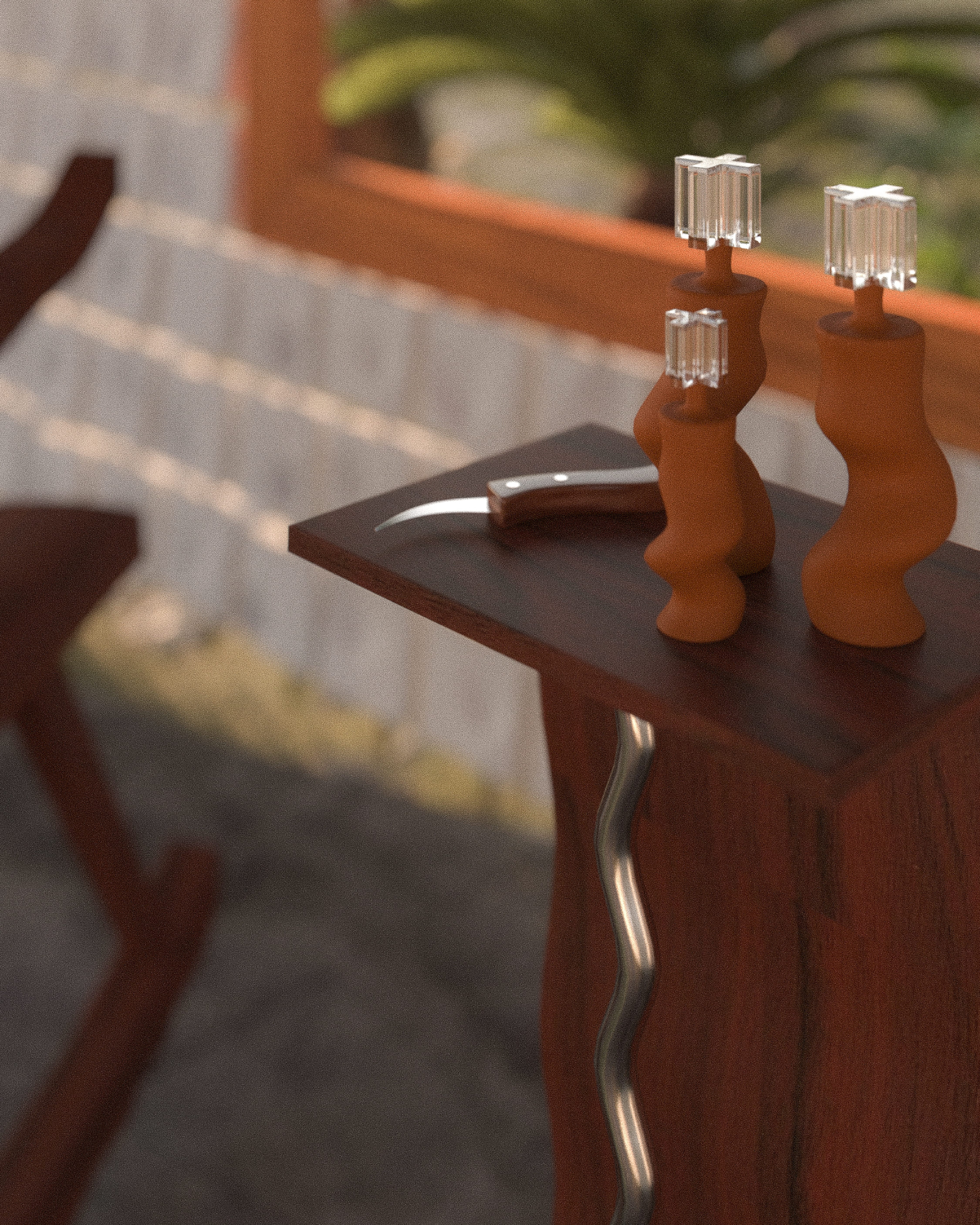
Essential Oils Bottles
Before settling comfortably into her "dodine", La Guiablesse grabs one of the bottles of essential oils to place a drop on some of the clay blocks that make up the wall-mounted perfume orgue. The knife is used to chop the tobacco before La Guiablesse inserts it into her pipe.
Before settling comfortably into her "dodine", La Guiablesse grabs one of the bottles of essential oils to place a drop on some of the clay blocks that make up the wall-mounted perfume orgue. The knife is used to chop the tobacco before La Guiablesse inserts it into her pipe.

The Jars
Context : inspired by the "water hut" in Martinique, this hut uses a cascading reservoir system. From the gutters, the water falls into jars built one on top of the other. Fitted with protective lids and strainers, they pour their overflow into each other, forming a drinking water reserve. The surplus flows into an outdoor basin for washing up or washing clothes, and then, down an open drain, into the garden.
Design : the jar is somewhat intriguing, with its farandole of handles accumulating all around the container. The wave-shaped part at the top imitates water moving on the surface.
Context : inspired by the "water hut" in Martinique, this hut uses a cascading reservoir system. From the gutters, the water falls into jars built one on top of the other. Fitted with protective lids and strainers, they pour their overflow into each other, forming a drinking water reserve. The surplus flows into an outdoor basin for washing up or washing clothes, and then, down an open drain, into the garden.
Design : the jar is somewhat intriguing, with its farandole of handles accumulating all around the container. The wave-shaped part at the top imitates water moving on the surface.

The Columns
Context : in the image of the majestic "fromager" tree, a large tropical tree found in the French West Indies, the structural columns of the hut are adorned with "spikes". These biomimic this sacred tree, recognisable by the enormous thorns that adorn its trunk.
Design : considered to be the devil's tree, La Guiablesse or Deviless uses these "thorns" to hang objects, textiles and so on.
Context : in the image of the majestic "fromager" tree, a large tropical tree found in the French West Indies, the structural columns of the hut are adorned with "spikes". These biomimic this sacred tree, recognisable by the enormous thorns that adorn its trunk.
Design : considered to be the devil's tree, La Guiablesse or Deviless uses these "thorns" to hang objects, textiles and so on.

The dominos
Context : dominoes are a very popular game in the French West Indies. It is part of the folklore. In Martinique, it is played by 3 rather than 4 players.
Design : this explains the triangular shape of the table. The dominoes are pierced with holes to indicate their numbering. That way, they can be stored vertically, along a rod. Their shape creates a pattern of fullness and emptiness when placed on the table. In the French West Indies, dominoes are played with such intensity, that dominoes, usually rectangular, seem to have been tightly held between the fingers.
Context : dominoes are a very popular game in the French West Indies. It is part of the folklore. In Martinique, it is played by 3 rather than 4 players.
Design : this explains the triangular shape of the table. The dominoes are pierced with holes to indicate their numbering. That way, they can be stored vertically, along a rod. Their shape creates a pattern of fullness and emptiness when placed on the table. In the French West Indies, dominoes are played with such intensity, that dominoes, usually rectangular, seem to have been tightly held between the fingers.
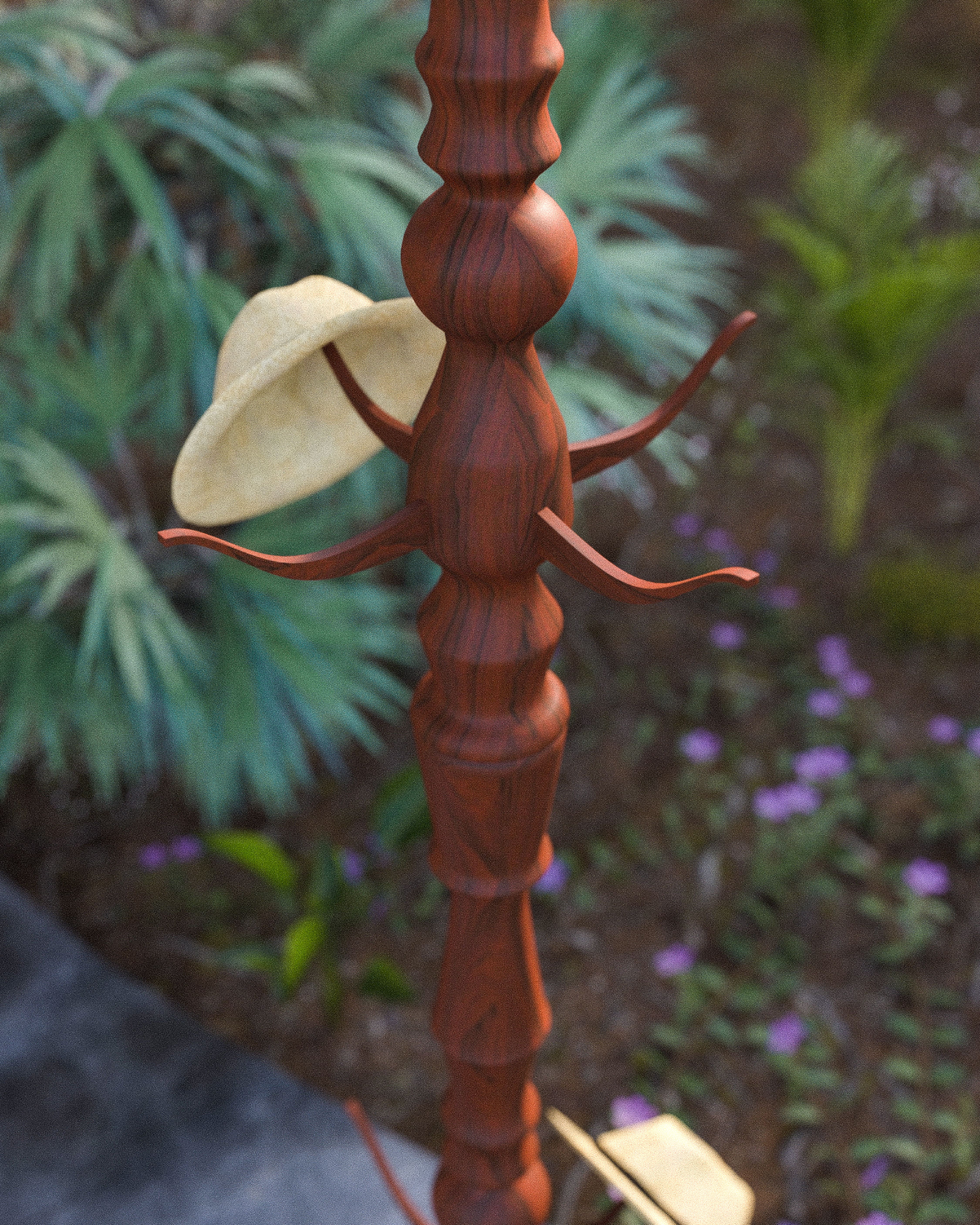
The Hat Column
Concept : one of the 12 structural columns of the square is different from the others. Like the Guiablesse with its goat's foot, this column appears as an anomaly.
Design : inspired by the furniture from yesteryear, this column is used by guests to hang their panama or bakoua hats.
Concept : one of the 12 structural columns of the square is different from the others. Like the Guiablesse with its goat's foot, this column appears as an anomaly.
Design : inspired by the furniture from yesteryear, this column is used by guests to hang their panama or bakoua hats.

The Stool
Inspiration : on an evening like any other, sitting on his stool around a crackling fire, Monsieur Médouze, the old man from the rue case nègre, tells Joseph a multitude of exciting stories.
History : in the West Indies, oral culture has endured through storytelling. Derived from the original African tale, the West Indian tale enabled slaves, forced to leave their homes, and later their descendants, to express their feelings and their rebellion against colonial society.
Design : the Guiablesse, a figure of the island's inhabitants, is also renowned for her storytelling talents. Her stool here symbolises this touching scenario between the old man and the young boy. Here the stool is designed as a totem object that pays tribute to these many tales. Like the Guiablesse with its goat's foot, the stool presents a particular “anomaly” with this organic foot that contrasts with the geometric aspect of the whole object. Civilised and disciplined, the Guiablesse nevertheless retains a subtle, but strong, wild and rebellious character.
Inspiration : on an evening like any other, sitting on his stool around a crackling fire, Monsieur Médouze, the old man from the rue case nègre, tells Joseph a multitude of exciting stories.
History : in the West Indies, oral culture has endured through storytelling. Derived from the original African tale, the West Indian tale enabled slaves, forced to leave their homes, and later their descendants, to express their feelings and their rebellion against colonial society.
Design : the Guiablesse, a figure of the island's inhabitants, is also renowned for her storytelling talents. Her stool here symbolises this touching scenario between the old man and the young boy. Here the stool is designed as a totem object that pays tribute to these many tales. Like the Guiablesse with its goat's foot, the stool presents a particular “anomaly” with this organic foot that contrasts with the geometric aspect of the whole object. Civilised and disciplined, the Guiablesse nevertheless retains a subtle, but strong, wild and rebellious character.

The Book Holder
Design : like the pipe-holder, the book-holder is a piece of furniture in its own right that highlights the emblem of the "indelible" tale. Not only through oral culture, but also through writing and books.
Its pointed shape serves as a bookmark for the book that is placed on it.
Design : like the pipe-holder, the book-holder is a piece of furniture in its own right that highlights the emblem of the "indelible" tale. Not only through oral culture, but also through writing and books.
Its pointed shape serves as a bookmark for the book that is placed on it.